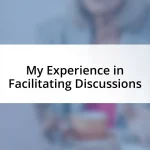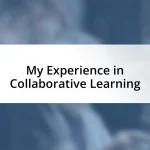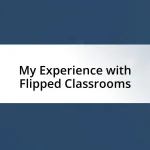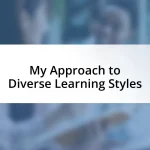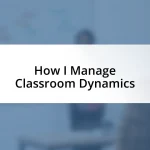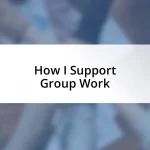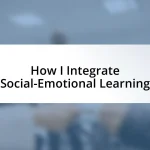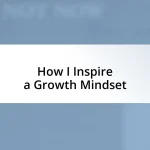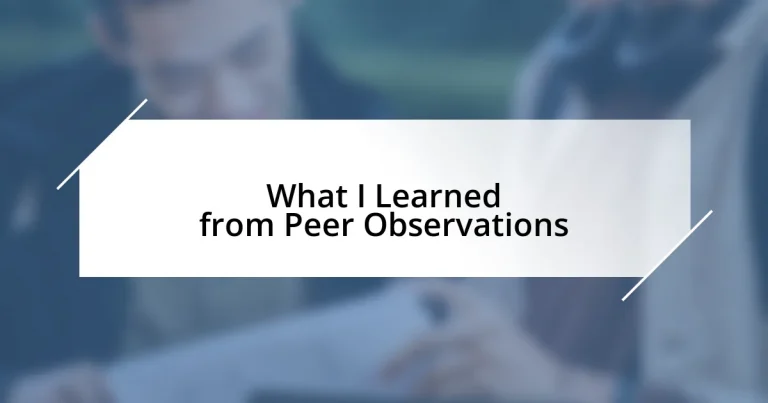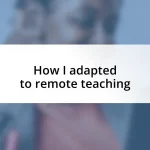Key takeaways:
- Peer observations foster a supportive environment that encourages feedback and collaboration, leading to professional growth.
- Setting clear goals and building rapport before observations enhances the experience and leads to more meaningful discussions.
- Constructive feedback should be analyzed and followed up with conversations to deepen understanding and facilitate continuous improvement.
- Integrating insights from observations can transform teaching practices and mindsets, fostering ongoing professional development.
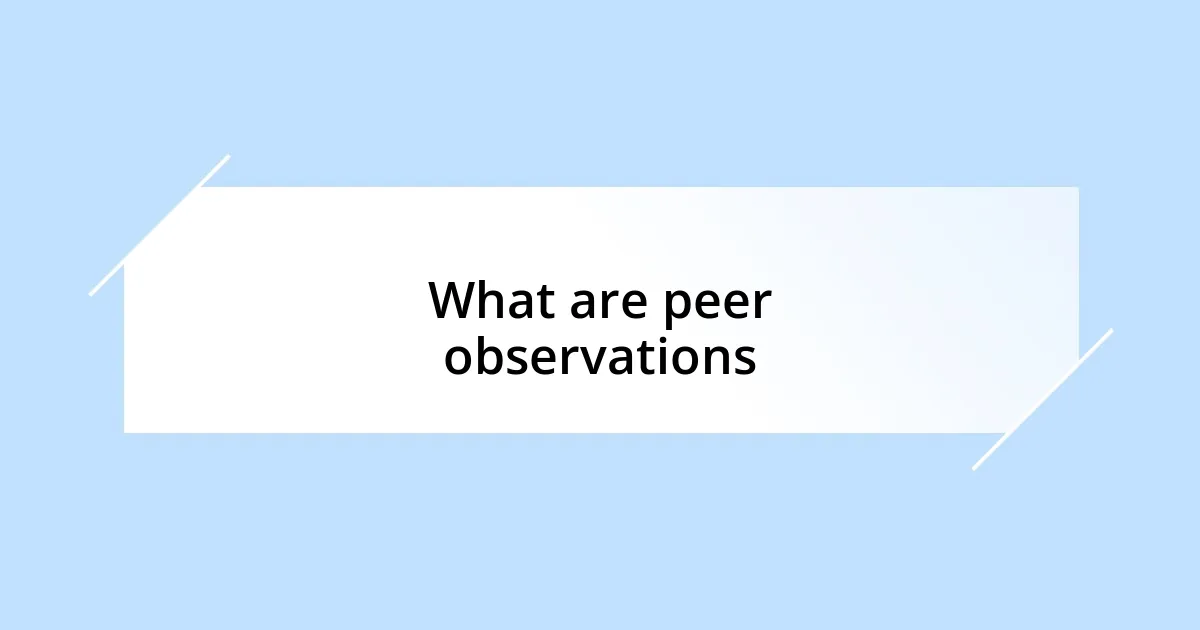
What are peer observations
Peer observations are when colleagues observe each other’s teaching practices to share insights and improve skills. It’s more than just watching someone teach; it’s a chance to reflect together on what works, what doesn’t, and what can be done differently for better outcomes. Have you ever felt nervous stepping into a colleague’s classroom, wondering if you’d pick up new strategies or just end up critiquing yourself?
Through my experience, I’ve found that peer observations can serve as a gateway to authentic professional development. I remember watching a fellow teacher incorporate technology seamlessly into her lessons. It was eye-opening to see how engagement soared when students used devices for interactive activities. I left her classroom feeling inspired, with a notebook full of ideas to implement in my own practice.
These observations foster a collaborative environment, creating a safe space for sharing feedback and best practices. It’s like having a supportive community that encourages you to step out of your comfort zone. Have you ever found that one small observation could shift your entire perspective on your teaching approach? That’s the beauty of peer observations; they can spark those “aha” moments that truly reshape our understanding of effective teaching.
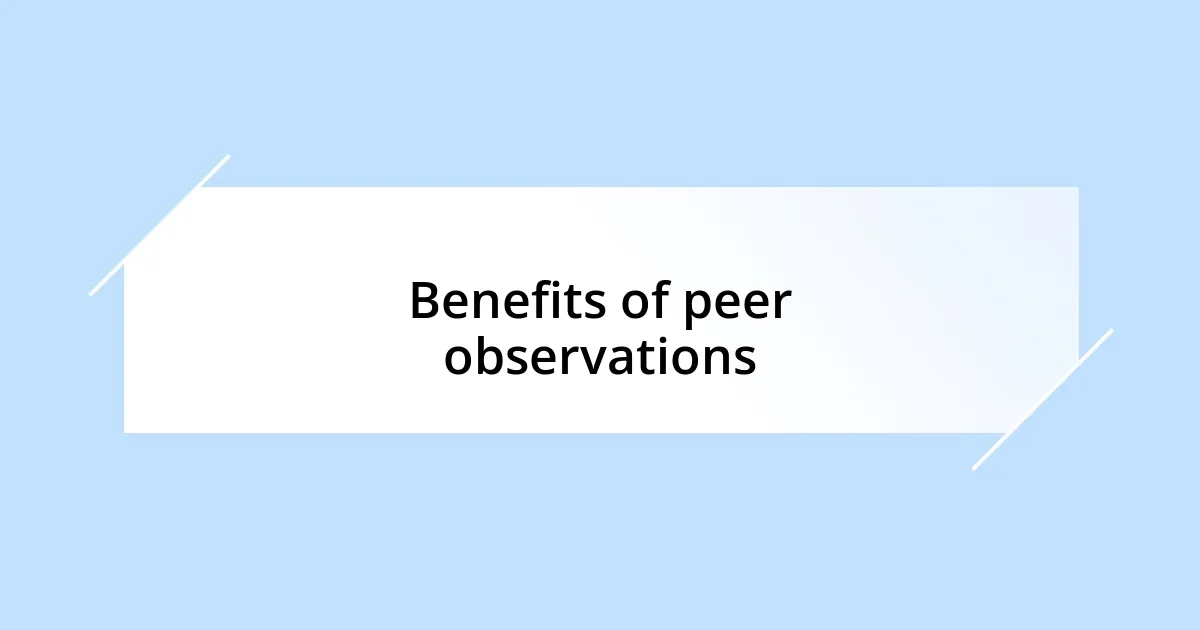
Benefits of peer observations
Peer observations bring a wealth of benefits that enhance teaching practices and promote professional growth. One of the most striking advantages I’ve encountered is the culture of trust and openness that develops among colleagues. I remember a time when I was hesitant to share my teaching methods, fearing judgment. However, after a few peer observations, I gradually found solace in honest discussions about our successes and challenges. This openness not only helps us improve but also fosters stronger relationships within the team.
Here are some key benefits of peer observations:
- Shared Learning: Watching a colleague can introduce innovative techniques or strategies previously unknown to you.
- Real-Time Feedback: Immediate insights from peers can directly influence your teaching approach.
- Increased Confidence: Observing others helps reinforce your own skills, leading to a greater sense of professional self-assurance.
- Reflective Practice: Engaging in conversations about each other’s methodologies encourages self-reflection and deeper thinking about one’s own strategies.
- Stronger Collaboration: Regular observations promote teamwork, enhancing the overall teaching environment for both teachers and students.
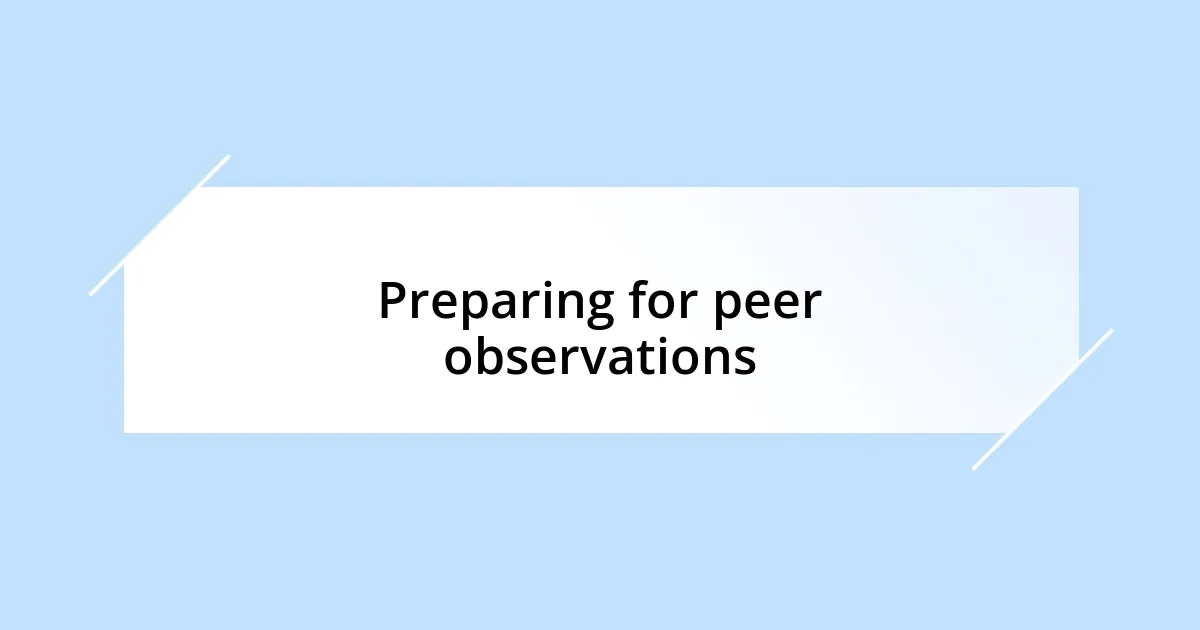
Preparing for peer observations
Preparing for peer observations involves a bit of groundwork to ensure that the experience is beneficial for everyone involved. I remember my first observation; I felt a mix of anxiety and excitement. To prepare, I took a moment to reflect on what I wanted my peer to focus on. Was it my classroom management, my teaching style, or perhaps the way I interacted with students? Setting a clear goal not only guided my peer’s observations but also shaped my own self-reflection afterward.
Creating an inviting atmosphere plays a significant role in the success of peer observations. I’ve found that informal chats with colleagues before the observation help to ease any tension. Sharing a cup of coffee while discussing expectations creates a comfortable environment. This comfort allows for open communication and honest feedback, which is vital for growth. Did you know that introducing casual interactions within the professional setting can pave the way for deeper, more meaningful discussions? In my experience, this approach significantly enhances the effectiveness of the observation process.
The logistical aspects shouldn’t be overlooked either. Coordinating schedules may seem mundane, but it’s crucial for maximizing participation. Establishing a clear timeline can alleviate stress and ensure that everyone is on the same page. I often find that putting added effort into these preparations yields great results, as teachers can then focus on the observation itself rather than logistics. Ultimately, investing time into preparations sets the stage for a rewarding peer observation experience.
| Preparation Aspects | Emotional Insights |
|---|---|
| Setting clear goals for the observation | Feeling a mix of anxiety and excitement can motivate you to reflect on your teaching. |
| Building rapport with peers | Casual conversations create a comfortable atmosphere, leading to open feedback. |
| Coordinating logistics effectively | Well-organized schedules reduce stress and allow teachers to focus on learning from each other. |
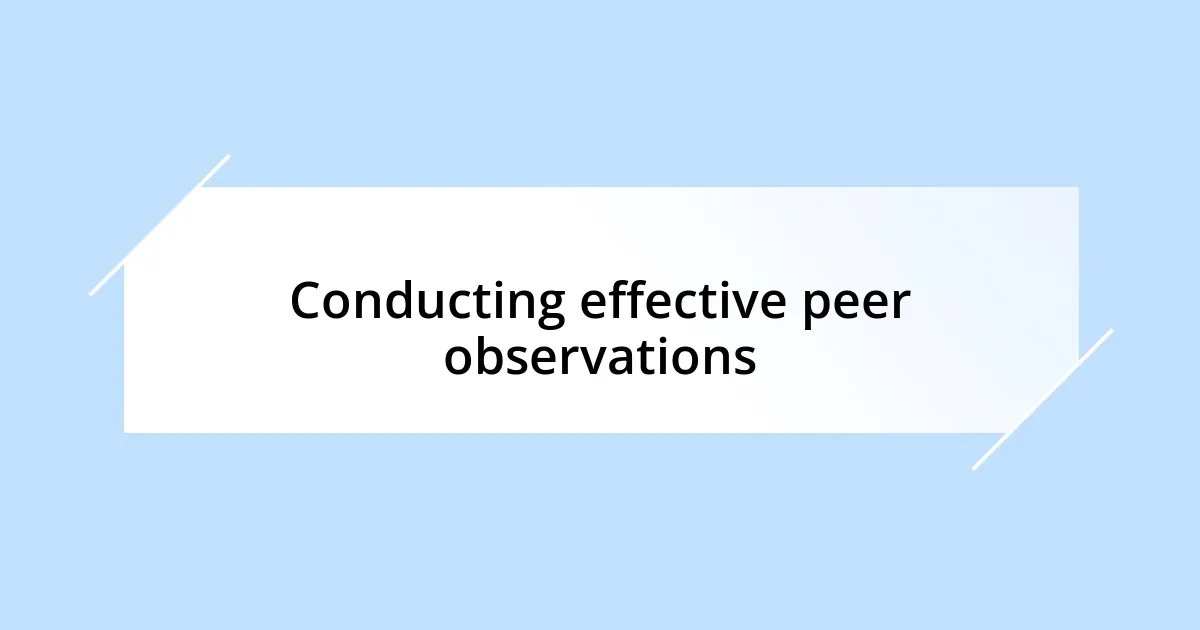
Conducting effective peer observations
Conducting effective peer observations relies heavily on open communication and constructive feedback. I’ve experienced firsthand how invaluable specific feedback can be. When I received feedback that pinpointed not just what worked but also areas for improvement, it felt like receiving a personalized roadmap for my teaching journey. Have you ever had that moment when a colleague’s insight completely shifted your perspective? Those moments are truly transformational.
It’s important to establish a mutual understanding of the observation process beforehand. I recall a time when a colleague and I decided to focus on student engagement during my lesson. By discussing our expectations prior to the observation, we were able to dive deeper into analyzing my methods afterward. This not only created clarity but also reinforced our commitment to learning from each other. It made me realize how essential it is to have these conversations upfront to extract maximum value from the experience.
Moreover, embracing vulnerability can lead to significant growth. I remember feeling exposed during an observation, thinking about how I would be perceived by my peers. However, that sense of vulnerability encouraged me to share my challenges openly, leading to incredibly rich discussions. Isn’t it fascinating how stepping outside your comfort zone can yield such profound insights? In many ways, this vulnerability builds a stronger foundation for collaboration, making the entire process not just about observation, but about genuine professional growth.
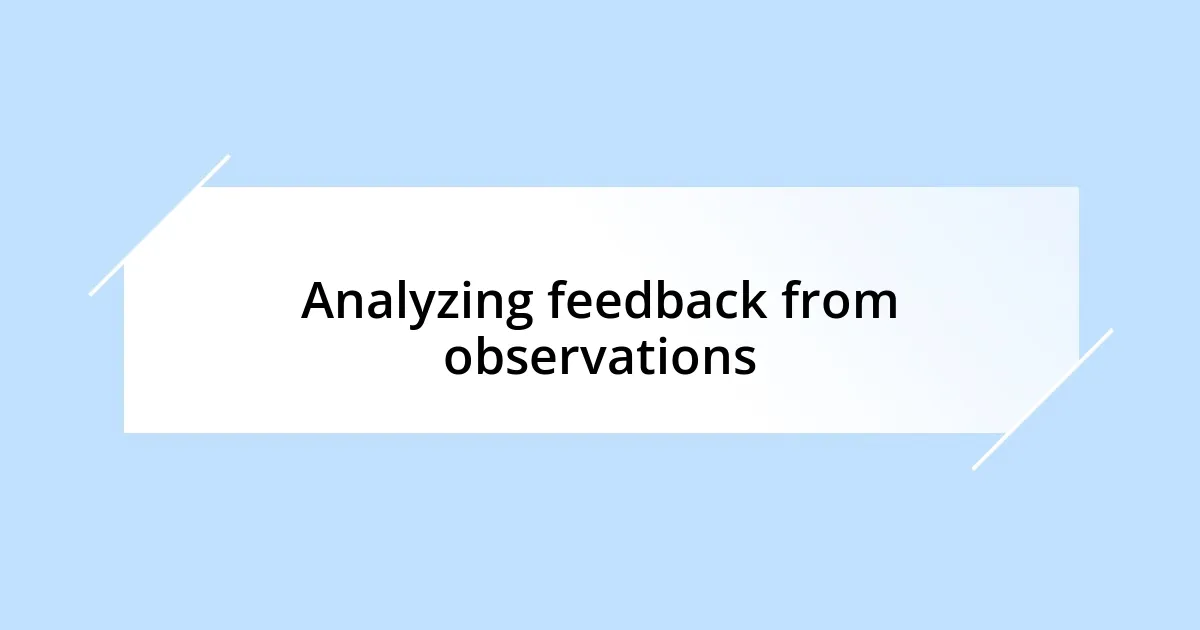
Analyzing feedback from observations
Analyzing feedback from observations can be a challenging, yet enlightening process. I distinctly remember the first time I sifted through feedback after a peer had observed my class. What struck me was the mix of reassurance and constructive criticism; it was like receiving a mirror reflecting not just my strengths, but also the areas I could develop further. Have you ever looked at feedback and felt both proud and deflated at the same time? That duality is often where the real learning happens.
As I delved deeper into the comments, I started to notice patterns—certain strengths that consistently garnered praise and specific challenges that were highlighted more than once. This pattern recognition taught me about my teaching identity and pushed me to think critically about my practices. I began to focus on how the feedback was framed and whether it resonated with my teaching philosophy. Understanding the nuances in feedback allowed me to prioritize changes that felt authentic to me, rather than simply making adjustments based on others’ opinions.
Lastly, I learned the importance of follow-up conversations. After reflecting on the initial feedback, I reached out to my peer for clarity on their observations. By engaging in a dialogue, we explored their insights more deeply, leading to a richer understanding of how to enhance my teaching methods. Isn’t it amazing how a simple conversation can transform feedback into a collaborative growth experience? In my view, these discussions not only deepen relationships with colleagues but also provide a platform for continuous learning.
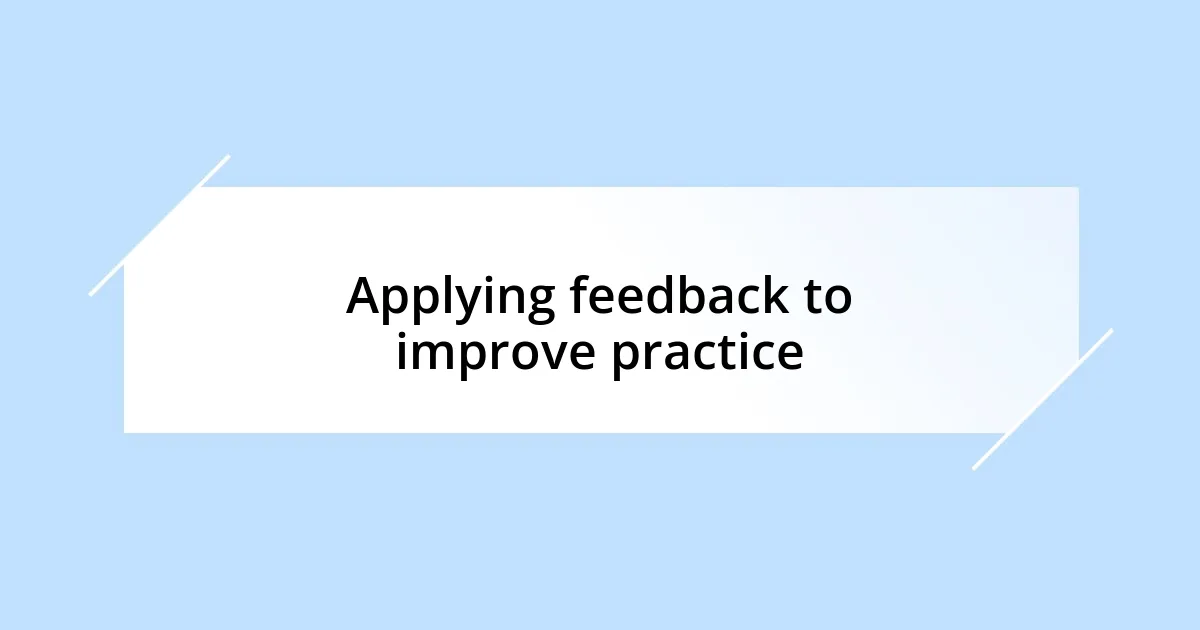
Applying feedback to improve practice
Applying feedback effectively can be a game changer in refining teaching practices. I vividly recall receiving feedback after an observation that highlighted my classroom management strategies. Although it felt uncomfortable at first—especially hearing about aspects I hadn’t recognized—I was driven to experiment with different techniques. Have you ever faced a challenge that ultimately led you to discover a more effective approach? This experience nudged me into a cycle of trial and reflection that deepened my understanding and improved how I manage my classroom.
When I started implementing the feedback, I felt a mix of excitement and apprehension. It was like stepping onto a tightrope; I knew adjustment was necessary but feared the outcome. I remember meticulously trying out a colleague’s suggestion to integrate more interactive elements into my lessons. Initially, it felt risky, but over time, as students became more engaged, my confidence grew. Sometimes, stepping out of our comfort zones is precisely what we need to unlock new levels of success in our practice.
One key takeaway for me was setting specific goals based on the feedback. After a thoughtful review of what my peer had observed, I decided to focus on one area at a time. For instance, I prioritized improving my questioning techniques for the following month. Each week, I would jot down reflections on how this shift affected student responses. It was fascinating to see the direct correlation between my focus on feedback and students participating more actively. Don’t you agree that setting targeted goals can transform vague suggestions into meaningful progress? This clarity was vital in my journey to enhance my teaching, motivating me to continuously iterate and evolve.
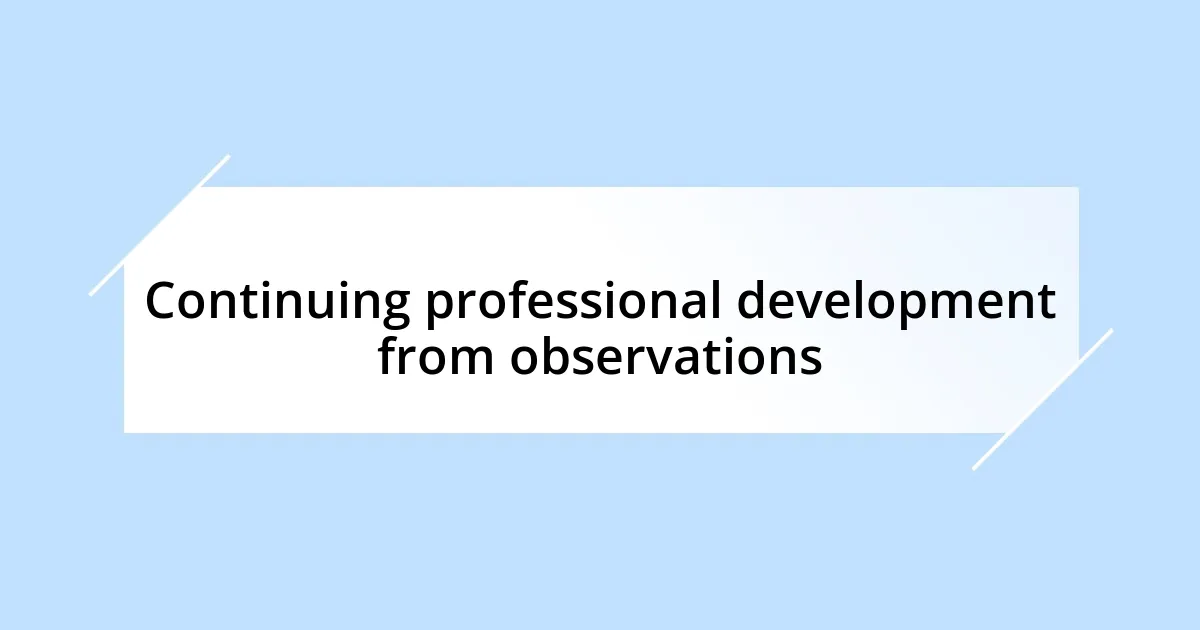
Continuing professional development from observations
Continuing professional development through observations is an enriching journey, one that I’ve found to be invaluable in enhancing my teaching practices. I remember a time when I felt particularly stuck in my methods. The observation was a pivotal moment; I received feedback that illuminated blind spots I hadn’t even considered. Have you ever felt a surge of clarity from someone else’s perspective? That’s what it felt like—like someone had turned on the lights in a dim room. Suddenly, I was encouraged to explore new pedagogical approaches that aligned better with my teaching goals.
As I began to integrate insights from these observations, an unexpected realization dawned on me: it wasn’t just about altering my lessons, but also about transforming my mindset. I decided to observe a peer’s class, and what I witnessed was inspiring. The energy in their room was contagious, and it ignited a spark in me. I started to think, “What if I brought that same level of energy into my classroom?” This question drove me to adopt creative techniques that not only energized my teaching but also fostered a more engaging atmosphere for my students. Isn’t it fascinating how watching someone else can propel us to rethink our own practices?
Over time, I recognized that continuous professional development requires intentionality. After each round of observations, I set aside time for reflection—writing down my thoughts helped me internalize and articulate my growth. I still remember the moment I connected past feedback with my evolving teaching style; it felt like piecing together a puzzle. I began regularly engaging with colleagues, sharing ideas and strategies, and this collaborative spirit transformed my ongoing growth into a shared experience. Have you ever felt the exhilaration of learning alongside peers? It’s like having a team cheering you on as you navigate the ups and downs of your professional journey, reinforcing that growth is not just an individual endeavor, but one that thrives in community.
